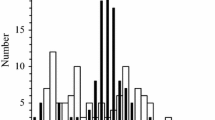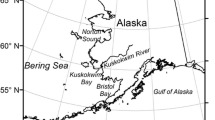Abstract
At least two phenotypes of lake charr, Salvelinus namaycush, coexist in Lake Superior. A lean morph frequents the shallow inshore waters (< 50 m) and the fat morph (siscowet) occupies the deeper offshore waters (50–250 m). The objective of this study was to determine if the elevated lipid concentration of siscowets reduces the costs of swimming in deep water. First, we modelled the effects of body composition (lipids) on the costs of swimming by lake charr, and then compared these theoretical results with empirical evidence obtained from Cesium 137-based estimates of food consumption, gross energy conversion, and swimming costs (activity multiplier). The attributes of growth, energy content (kJ g-1), lipid concentrations, and Cesium 137 concentration (Bq g-1) were obtained from multimesh gillnet catches in eastern Lake Superior (1998 and 1999). The model showed that siscowet (fat) lake charr expended less energy than lean lake charr moving through the water column. Empirical evidence derived from Cesium 137 analysis confirmed that the activity multipliers of siscowets (fat) were less than those for lean charr. These findings support the view that the restoration of the fish community of the predominately deep water of the Great Lakes might be facilitated by the introduction of the fat phenotype.
Similar content being viewed by others
References cited
Alexander, R.M. 1966. Physical aspects of swimbladder function. Biol. Rev. 41: 141–176.
Alexander, R.M. 1972. The energetics of vertical migration of fishes. pp. 273–294. In: M.A. Sleigh & A.G.M. MacDonald (ed.) The Effects of Pressure on Organisms, Symp. Soc. Exper. Biol. No. 26, Cambridge.
Arnold, G.P. & M.G. Walker. 1992. Vertical movements of cod (Gadus morhua L.) in the open sea and the hydrostatic function of the swimbladder. ICES J. Mar. Sci. 49: 357–372.
Boisclair, D. & P. Sirois. 1993. Testing assumptions of fish bioenergetic models by direct estimation of growth, consumption, and activity rates. Trans. Amer. Fish. Soc. 122: 784–796.
Bronte, C.R. 1993. Evidence of spring spawning lake trout in lake Superior. J. Great Lakes Res. 19: 625–629.
Burnham-Curtis, M.K. & G.R. Smith. 1994. Osteological evidence of genetic divergence of lake trout (Salvelinus namaycush) in Lake Superior. Copeia 1944: 843–850.
Eschmeyer, P.H. & A.M. Phillips. 1965. Fat content of the flesh of siscowets and lake trout from Lake Superior. Trans. Amer. Fish. Soc. 94: 62–74.
Elliott, J.M. & L. Persson. 1978. The estimation of daily rates of food consumption for fish. J. Anim. Ecol. 47: 561–580.
Elrod, J.H. & C.P. Schneider. 1987. Seasonal bathythermal distribution of juvenile lake trout in Lake Ontario. J. Great Lakes Res. 13: 1221–1134.
Galligan, J.P. 1963. Depth distribution of lake trout and associated species in Cayuga Lake, New York. N.Y. Fish Game J. 10: 44–68.
Hanson, P.C., J.W. Peck, R.G. Schorfhaar, J.H. Selgeby, D.R. Schreiner, S.T. Schram, B.L. Swanson, W.R. MacCallum, M.K. Burnham-Curtis, G.L. Curtis, J.W. Heinrich & R.J. Young. 1995. Lake trout (Salvelinus namaycush) populations in Lake Superior and their restoration, 1959- 1993. J. Great Lakes Res. 21 (Suppl. 1): 152–175.
He, J. & D.J. Stewart. 1997. Comment-measuring the bioenergetic cost of fish activity in situ using a globally dispersed radiotracer (137Cs). Can. J. Fish. Aquat. Sci. 54: 1953–1954.
Henderson, B.A. & S.J. Nepszy. 1994. Reproductive tactics of walleye (Stizostedion vitreum) in Lake Erie. Can. J. Fish. Aquat. Sci. 51: 986–997.
Henderson, B.A. & J.L. Wong. 1998. Control of lake trout reproduction: role of lipids. J. Fish Biol. 52: 1078–1082.
Ihssen, P. & J.S. Tait. 1974. Genetic differences in retention of swimbladder gas between two populations of lake trout (Salvelinus namaycush). J. Fish. Res. Board Can. 31: 1351–1354.
Kanwisher, J. & A. Ebeling. 1957. Composition of the swimbladder gas in bathypelagic fishes. Deep Sea Research 4: 211–217.
Kerr, S.R. 1971. Prediction of fish growth efficiency in nature. J. Fish. Res. Board Can. 28: 809–814.
Magnusson, J.J. 1970. Hydrostatic equilibrium of Euthynnus affinus, a pelagic teleost without a gas bladder. Copeia 1970: 56–85.
Martin, G.W. 1969. Factors affecting retention of swimbladder gas in lake and brook trout and their hybrids. M.Sc. Thesis, York University, Toronto. 78 pp.
Martin, N.V. 1952. A study of the lake trout, Salvelinus namaycush, in two Algonquin Park, Ontario, lakes. Trans. Amer. Fish. Soc. 81: 111–137.
Martin, N.V. & C.H. Olver. 1980. The lake charr, Salvelinus namaycush. pp. 205–277. In: E.K. Balon (ed.) Charrs, Salmonid Fishes of the Genus SalvelinusI, Dr W Junk Publishers, The Hague.
Robinson, W.R., R.H. Peters & J. Zimmerman. 1983. The effects of body size and temperature on metabolic rate of organisms. Can. J. Zool. 61: 281–288.
Rowan, D.J. & J.B. Rasmussen. 1994. Bioaccumulation of radiocesium by fish: the influence of physiochemical factors and trophic structure. Can. J. Fish. Aquat. Sci. 51: 2388–2410.
Rowan, D.J. & J.B. Rasmussen. 1995. The elimination of radiocesium from fish. J. Appl. Ecol. 32: 739–744.
Rowan, D.J. & J.B. Rasmussen. 1996. Measuring the bioenergetics of fish activity in situ using a globally dispersed radiotracer (137Cs). Can. J. Fish. Aquat. Sci. 53: 734–745.
Rowan, D.J. & J.B. Rasmussen. 1997. Reply - measuring the bioenergetic cost of fish activity in situ using a globally dispersed radiotracer (137Cs). Can. J. Fish. Aquat. Sci. 54: 1955–1956.
Straight, W.J. 1969. Depth distribution of splake of known ability to retain swimbladder gas. M.Sc. Thesis, York University, Toronto. 45 pp.
Tait, J.S. 1972. A method of selecting trout hybrids (Salvelinus fontinalis x S. namaycush ) for ability to retain swimbladder gas. J. Fish. Res. Board Can. 27: 39–45.
Thurston, C.E. 1962. Physical characteristics and chemical composition of two subspecies of lake trout. J. Fish. Res. Board Can. 19: 39–44.
Walters, C.J., G. Steer & G.R. Spangler. 1980. Responses of lake trout (Salvelinus namaycush) to harvesting, stocking, and lamprey reduction. Can. J. Fish. Aquat. Sci. 37: 2133–2145.
Weast, R.C. (ed.) 1989. Handbook of chemistry and physics. CRC Press Inc., Boca Raton. 2435 pp.
Webb, P.W. 1975. Hydrodynamics and energetics of fish propulsion. Bull. Fish. Res. Board Can. 190, Ottawa, 159 pp.
Author information
Authors and Affiliations
Rights and permissions
About this article
Cite this article
Henderson, B.A., Anderson, D.M. Phenotypic Differences in Buoyancy and Energetics of Lean and Siscowet Lake Charr in Lake Superior. Environmental Biology of Fishes 64, 203–209 (2002). https://doi.org/10.1023/A:1016023027437
Issue Date:
DOI: https://doi.org/10.1023/A:1016023027437




